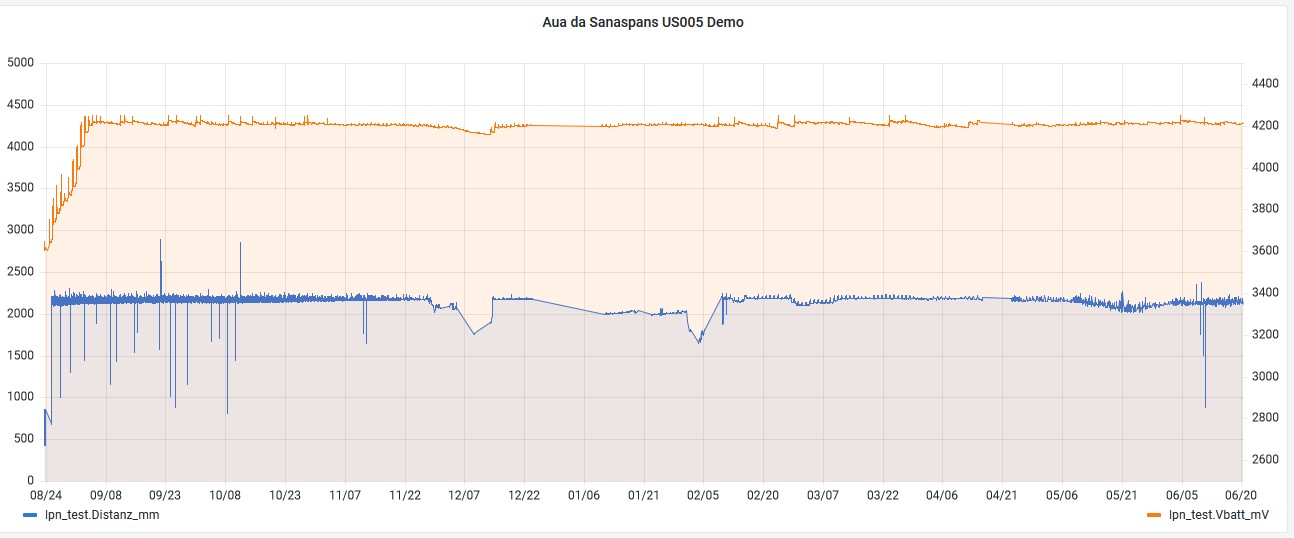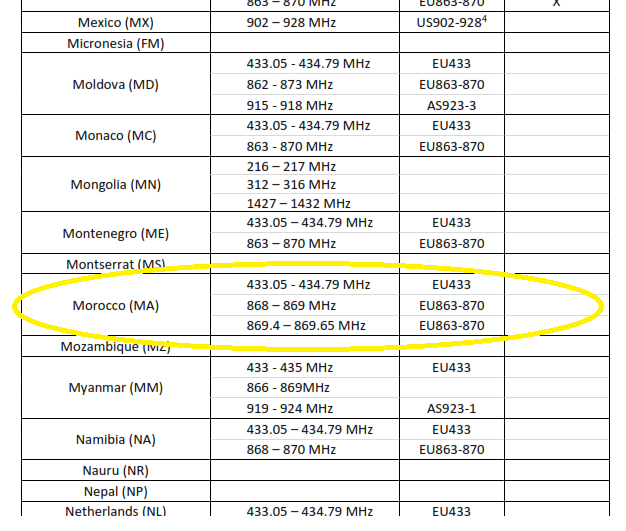and use this AT Command sketch demo:
I’ve been using CubeCell boards for about two years now (around 20 boards) and really recommend them.
One thing I’ve noticed is that they seem to dislike moisure. Of course, no electronic device does ![]()
But I had several AB02A stop working (outdoor). When opening the case there was a small amount of condensation inside the case. After drying the units started to work again. I don’t blame the boards for it, but maybe this hint is useful for someone facing the same situation. I highly recommend to use pressure compensation units on the case.
I have used solar power on AB02 for almost a year, and this works well for me. I am using a 18650 li ion cell with a small 1 W solar panel (full exposure to sunlight for at least 4 hours year-round). Of course, this is no scientific analysis, but below there is some data from this setup (sending payload every 15 min SF7). After installing the node outdoors, the Li ion gets charged up and then pretty much stays at full charge for the rest of the time. Some heavy snowfalls covered the panel (and the sensor), thats where the voltage drops a little.

Hello all,
i can confirm both findings…
one i have a cube cell connected to a lithium battery that is rated at 3000mah and produced 2500mah during test with a cut off voltage at 3.5v to protect the battery. currently the cubecell HTCC-AB01 is connected to this battery and sending a 38 byte payload every single minute, and so far it has sent 20,000.00 frames and the battery voltage is still at 4.1v, so it is promising, the board will continue to run until the voltage of the battery hits 3.5v, once there i will report my findings.
for the humidity issue, i actually suspect heat and humidity can cause some real issues for these boards as i have observed the same exact thing mentioned above. in one case the board stopped working and actually depleted the battery completely. so yes one had to take care in placing them in a sealed case (IP68) i would assume.
at what SF? air time approx doubles for each step and hence has huge impact with high throughput messaging wrt battery life… remember also FUP!
A battery that has a nominal voltage of 3.2V???
Not only mathematically unlikely as the LiPo curve dives under 4V very quickly, but promising you a visit to the court to pay the fine for the over use of the airwaves. As well as being in breach of the FUP as above.
68? Dust proof and submergible for up to 30 minutes - where will the heat go? LiPo on thermal runaway experience for the win!
Heat can only be dissipated via convection or force cooling - so the case needs holes. Humidity is take care of with appropriate sealants on the PCB. If the LiPo suffers from humidity problems, that means the Lithium is exposed to air which usually means a thin trail of smoke leading to, er, thermal runaway. So don’t buy LiPo’s that aren’t sealed and keep them in the suggested temperature range of 0℃ to 40℃ with outside limits of -20℃ to 60℃. Putting electronics in a sealed box will almost certainly stay warm - we know this from High Altitude Ballooning - if we’ve over-sealed the box it stays +10℃ whilst it is -45℃ on the outside.
i’m in a country that hasn’t establish the usage requirement yet so no usage limits imposed by law as of now ![]()
lol i never said it was done on TTN ![]()
so a judge that assumes, can’t never rule fairly. who knows i may have just done my tests inside a faraday cage ![]()
sure, what i was saying is that given 20k uploads means i can easily get 4-5 years battery life by sending an upload every two hours, longer life if i go to three… ![]() and eventually i’ll be using a (Li-SOCl2) for a longer battery life…
and eventually i’ll be using a (Li-SOCl2) for a longer battery life…
You sure?
Funny, I could have sworn that they had declared enough that the L-A is atleast comfortable/confident to declare a LoRaWAN frequency/channel set for the territory - albeit with a slightly reduced/offset channel plan set. I had a client asking on this for a couple of potential applications a year or two back (oil and gas/industrial monitoring & intensve agriculture - I think greenhouse/irrigation monitoring)…from the L-A RP 2-1.0.1 from early 2020:

Perhaps your friends at Moroc Telecom or in ANRT can provide you with definitive guidance?
https://www.anrt.ma/en/missions/spectre-des-frequences
…a Faraday cage indeed always a good idea if in doubt! ![]()
So off topic for this forum, goodbye
Hi, thanks a lot for all the infos you share!
I read your post on the diode and I have a question.
If I power my board trough the battery Lipo connector and i connect a solar panel to the Vs do I still have to use the diode even if I will never connect anything to the USB/Vin?
I have no electronics knowledge but from your post I assumed that the diode is needed to avoid current going from Vin/USB to Vs when Vin/USB are connected. So I assume that if I only use the Vs and the battery connectors I don’t need a diode… am I wrong?
One more question, the documentatioon says that I can employ solar panels from 5.5V to 7V, what does it happen if I use a solar panel with a lower voltage? like 5V or even 3V? Can I do that?
Sorry for the dumb questions, and thanks a lot for the effort, you are helping a lot
Super Grateful for all posts on this Heltec CubeCell topic ![]()
Please can I ask the following questions regarding the AB02A.
As I am considering purchasing 10 or more of the AB02A units,
trying to evaluate IF & HOW they can achieve the following:
(I am newbie to coding/LoRa, been looking at general online related info for, 12 months on and off)
When looking at the examples in Arduino IDE - Arduino/File/Examples there is coding available,
but, am wondering how much of general arduino coding (there may be alot more helpful public/freeware sketches/coding examples) could be also useful for the cubecell users community.
Any advice on how to make use of this resource if it is possibly available and useful (If I knew how).
Also, (maybe helpful to other beginners) I saw a great blog on you tube that explains the purpose of the pins:
https://robojax.com/learn/arduino/2020Patreonuuythgt5463r.php?vid=robojax_Heltec_CubeCell-AB01
Please, another question, If using a transmitting cubecell unit (switch on/off signal into GPIO pin) to for example control a (GPIO pin activates relay switch out) on a receiving cubecell unit, If there is range issues between transmitter and receiver, can/how do I use another cube cell unit between the primary transmitter and receiver to extend the range (e.g go around a rock/cliff or generally achieve a ‘mesh’ network so all cube cell units can be used to enhance the overall transmission capacity within this modular system. Is there code available for other arduino that could be purposed for this that people know of?
As the AB02A has SMA versus IPEX antenna connection on AB02, but AB02A has no OLED,
any advice on plugging off the shelf OLED into AB02A serial & just getting existing code from the AB02?
Dunno if this post is excessive, but if can point beginners with these types of question to learning resources, could overcome ‘energy activation barrier’ and encourage more hobbyist/DIY projects in this exciting field, Thanks
Im not an expert, but this might help:
can regulate voltage increasing ‘boosting’ or decreasing ‘bucking’ with general DC electronics,
The following (example) might be worth checking out:
search aliexpress for: Adjustable2577 DC-DC Step Up
hope its useful
TTN and this forum are about LoRaWAN which is not a point to point or mesh network. For those applications please find another forum.
Hi everyone, might be a bit late, but is there a way to read the voltage (and eventually the current) provided by the solar panel I will use to power my HTCC-AB01 without using external components?
I read in the forum that the analog input of HTCC-AB01 can read up to 3.7V but the solar panel output may reach 5V so I guess I can’t just read the voltage trough an analog pin.
Feed the monitoring input via a resistor ladder network/voltage divider and simply scale values in your encoder/decoder accordingly. A 2:1 would allow you to monitor panel output up to nominal 7.4V. Be careful as solar panels under light/low/no load in full sun can go much higher than their rated nominal output so you may need to read specs and details and if needed arrange a suitable over voltage protection for the input.
Hello I am currently running a helium weather station with LHT65, LHT52 and IKEA Hack air quality sensor. Now I would like to integrate an anemometer via a heltec CubeCell HTCC-AB01. Maybe someone already has a sketch and a decoder that I can use? I’m not a programmer and need help.
Is there perhaps a good documentation on CubeCell programming?
Thank you and best regards
Sorry but this is the Forum for The Things Network not Helium…funded by TTI for the benefit of TTN & TTI/The Things Stack users…
You should try the Helium forum/discord.
Thanks for the hint. Helium is not the problem. I’m already planning to switch the weather station to TTS. My problem is that I’m looking for a sketch and a decoder to operate an anemometer. It is currently running on an Arduino UNO for testing and should then run on a CubeCell.
Who can help me? I’m not a programmer.
Many Thanks
Code:
#include <Wire.h>
#include <Adafruit_GFX.h>
#include <Adafruit_SSD1306.h>
#define SCREEN_WIDTH 128 // OLED display width, in pixels
#define SCREEN_HEIGHT 64 // OLED display height, in pixels
// Declaration for an SSD1306 display connected to I2C (SDA, SCL pins)
Adafruit_SSD1306 display(SCREEN_WIDTH, SCREEN_HEIGHT, &Wire, -1);
const int RecordTime = 3; //Define Measuring Time (Seconds)
const int SensorPin = 3; //Define Interrupt Pin (2 or 3 @ Arduino Uno)
int InterruptCounter;
float WindSpeed;
void setup()
{
Serial.begin(9600);
display.begin(SSD1306_SWITCHCAPVCC, 0x3C);
}
void loop()
{
meassure();
Serial.print(“Wind Speed: “);
Serial.print(WindSpeed); //Speed in km/h
Serial.print(” km/h - “);
Serial.print(WindSpeed / 3.6); //Speed in m/s
Serial.println(” m/s”);
display.clearDisplay();
display.setTextSize(1);
display.setTextColor(WHITE);
display.setCursor(0, 10);
display.println(“Wind Speed: “);
display.setCursor(0, 20);
display.println(WindSpeed);
display.setCursor(50, 20);
display.println(” km/h “);
display.setCursor(0, 40);
display.println(WindSpeed / 3.6);
display.setCursor(50, 40);
display.println(” m/s”);
display.display();
}
void meassure() {
InterruptCounter = 0;
attachInterrupt(digitalPinToInterrupt(SensorPin), countup, RISING);
delay(1000 * RecordTime);
detachInterrupt(digitalPinToInterrupt(SensorPin));
WindSpeed = (float)InterruptCounter / (float)RecordTime * 2.4;
}
void countup() {
InterruptCounter++;
}
The Arduino forums might be a better place to ask questions that are specific to Arduinos
And if your not a programmer then Arduino do have a forum where you can ask people to write code for you.
And if you aren’t a user of any word processing packages, please be aware of the code formatting tools like </> for any future posts.
As alluded to by @LoRaTracker, you are unable to suddenly find someone write the whole program for you, particularly on a LoRaWAN implementation on one of the more notoriously tricky devices.
Are you clairvoyant, or why do you say that?
A forum is there to ask for help.
It could be that maybe someone has implemented such an application before. After all, I’m asking my question in a CubeCell forum and not in the animal magazine!!
Thanks